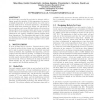Free Online Productivity Tools
i2Speak
i2Symbol
i2OCR
iTex2Img
iWeb2Print
iWeb2Shot
i2Type
iPdf2Split
iPdf2Merge
i2Bopomofo
i2Arabic
i2Style
i2Image
i2PDF
iLatex2Rtf
Sci2ools
HRI
2006
ACM
2006
ACM
The art of designing robot faces: dimensions for human-robot interaction
As robots enter everyday life and start to interact with ordinary people the question of their appearance becomes increasingly important. A user’s perception of a robot can be strongly influenced by its facial appearance. Synthesizing relevant ideas from narrative art design, the psychology of face recognition, and recent HRI studies into robot faces, we discuss effects of the uncanny valley and the use of iconicity and its effect on the self/other perceptive divide, as well as ness and realism, classifying existing designs along these dimensions. The dimensions and issues of face design are illustrated in the design rationale, details of construction and intended uses of a new minimal expressive robot called KASPAR.
| Added | 13 Jun 2010 |
| Updated | 13 Jun 2010 |
| Type | Conference |
| Year | 2006 |
| Where | HRI |
| Authors | Mike Blow, Kerstin Dautenhahn, Andrew Appleby, Chrystopher L. Nehaniv, David Lee |
Comments (0)

